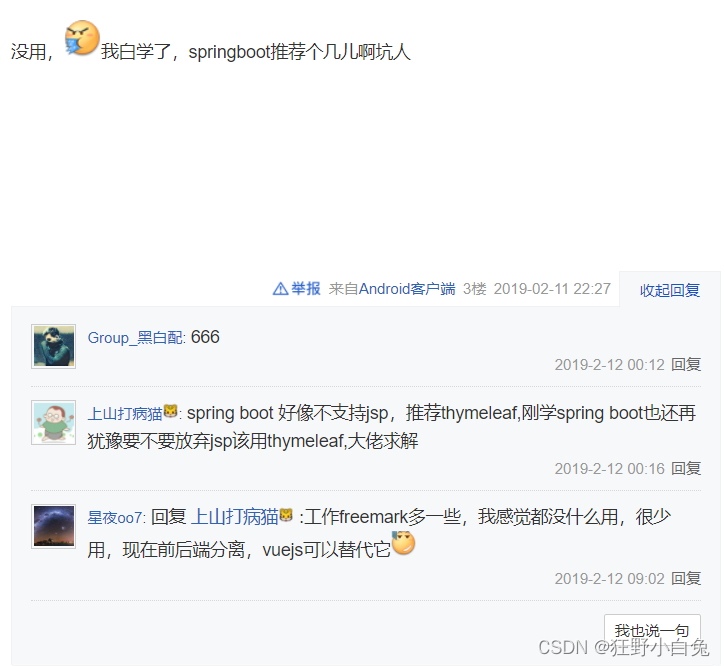SpringBoot Web开发
回顾:
自动装配
1. 创建应用,选择模块
SpringBoot到底帮我们配置了什么?我们能不能进行修改?能修改那些东西?能不能扩展?
- xxxAutoConfiguration->向容器中自动配置组件
- 在spring.factories文件中
- xxxProperties->自动配置类,装配配置文件中自定义的一些内容!
现在要解决的问题:
- 导入静态资源…怎么导入?
- 首页
- jsp页面…模板引擎Thymeleaf
- 装配和扩展SpringMVC
- 视图解析器
- 增删改查
- 拦截器
- 国际化【了解】
- 实现中英文切换
一、静态资源
以下源码路径:
- WebMvcAutoConfiguration【重点】—>addResourceHandlers(方法)—>WebProperties—>Resources(方法)
addResourceHandler(registry, "/webjars/**", "classpath:/META-INF/resources/webjars/");
private static final String[] CLASSPATH_RESOURCE_LOCATIONS = { "classpath:/META-INF/resources/",
"classpath:/resources/", "classpath:/static/", "classpath:/public/" };
- 以上路径都可以用来存放静态资源webjars,resources,static,public,/**(Resources根目录下的)【会自动查询以上目录】
根据上面建立静态资源目录

优先级:
resources>static>public
访问:
- 在Public中创建一个1.js
- 访问http://localhost:8080/1.js即可
各个目录的用途:
- public:一般放一些公共的资源(比如大家都会去访问的js)
- static:里面放一些静态资源和首页(比如图片)
- resources:放一些upload的上传文件
总结**:
-
在springboot,我们可以使用以下方式处理静态资源
- webjars
- 访问路径:localhost/8080/webjars/下面的目录结构
- 比如:localhost:8080/webjars/jquery/3.6.0/jquery.js
- resources,static,public,/**(Resources根目录下的)
- 访问路径:localhost:8080/
- webjars
-
优先级:resources>static(默认)>public
-
自定义静态资源(一旦使用了就会让原有的失效)——一般不使用
-
spring: mvc: static-path-pattern: /myUrl
-
二、首页如何定制
- 注:在Resources/templates目录下的所有页面,只能通过Controller来进行跳转。
- 这个需要模板引擎的支持【thymeleaf】
三、模板引擎【thymeleaf】
- 模板引擎的作用就是我们来写一个页面模板
- 以前用jsp,现在用thymeleaf
注:是前后端分离过程中的中间产物

结论:只要使用thymeleaf,只需要导入对应的依赖就可以了,我们将html放在我们的template目录下即可
-
<!--thymeleaf--> <dependency> <groupId>org.thymeleaf</groupId> <artifactId>thymeleaf-spring5</artifactId> </dependency> <dependency> <groupId>org.thymeleaf.extras</groupId> <artifactId>thymeleaf-extras-java8time</artifactId> </dependency>
如何使用thymeleaf
-
导入约束,命名空间
-
xmlns:th="http://www.thymeleaf.org"> -
所有的html元素都可以被thymeleaf替换接管
- th: 元素名
-
标准表达式语法
-
Simple expressions:(表达式语法) Variable Expressions: ${...}:获取变量值;OGNL; 1)、获取对象的属性、调用方法 2)、使用内置的基本对象:#18 #ctx : the context object. #vars: the context variables. #locale : the context locale. #request : (only in Web Contexts) the HttpServletRequest object. #response : (only in Web Contexts) the HttpServletResponse object. #session : (only in Web Contexts) the HttpSession object. #servletContext : (only in Web Contexts) the ServletContext object. 3)、内置的一些工具对象: #execInfo : information about the template being processed. #uris : methods for escaping parts of URLs/URIs #conversions : methods for executing the configured conversion service (if any). #dates : methods for java.util.Date objects: formatting, component extraction, etc. #calendars : analogous to #dates , but for java.util.Calendar objects. #numbers : methods for formatting numeric objects. #strings : methods for String objects: contains, startsWith, prepending/appending, etc. #objects : methods for objects in general. #bools : methods for boolean evaluation. #arrays : methods for arrays. #lists : methods for lists. #sets : methods for sets. #maps : methods for maps. #aggregates : methods for creating aggregates on arrays or collections. ================================================================================== Selection Variable Expressions: *{...}:选择表达式:和${}在功能上是一样; Message Expressions: #{...}:获取国际化内容 Link URL Expressions: @{...}:定义URL; Fragment Expressions: ~{...}:片段引用表达式 Literals(字面量) Text literals: 'one text' , 'Another one!' ,… Number literals: 0 , 34 , 3.0 , 12.3 ,… Boolean literals: true , false Null literal: null Literal tokens: one , sometext , main ,… Text operations:(文本操作) String concatenation: + Literal substitutions: |The name is ${name}| Arithmetic operations:(数学运算) Binary operators: + , - , * , / , % Minus sign (unary operator): - Boolean operations:(布尔运算) Binary operators: and , or Boolean negation (unary operator): ! , not Comparisons and equality:(比较运算) Comparators: > , < , >= , <= ( gt , lt , ge , le ) Equality operators: == , != ( eq , ne ) Conditional operators:条件运算(三元运算符) If-then: (if) ? (then) If-then-else: (if) ? (then) : (else) Default: (value) ?: (defaultvalue) Special tokens: No-Operation: _
thymeleaf语法
-
文档第十条里面
-

-
常用:
-
遍历数据:
-
@RequestMapping("/test") public String test(Model model) { model.addAttribute("users", Arrays.asList("kami", "dog")); return "test"; } -
<!--遍历出来的每个元素,展现到文本上--> <!--第一种写法——推荐使用--> <h3 th:each="users : ${users}" th:text="${users}"></h3> <!--第二种写法--> <!--<h3 th:each="users : ${users}">[[${users}]]</h3>--> -
前端基本都用的是三元运算符来实现判断
-
-
四、装配和扩展SpringMVC【重点】
自定义视图解析器
-
//如果你想自定义一些定制化的功能,只要写这个组件,然后将它交给springboot,springboot就会自动装配 //全面扩展 springMVC @Configuration public class MyMvcConfig implements WebMvcConfigurer { //ViewResolver 实现了视图解析器接口的类,我们就可以把它看做是视图解析器 @Bean public ViewResolver MyViewResolver(){ return new MyViewResolver(); } //自定义了一个自己的试图解析器MyViewResolver(静态内部类) public static class MyViewResolver implements ViewResolver{ @Override public View resolveViewName(String s, Locale locale) throws Exception { return null; } } }
重写页面跳转
-
//如果我们要扩展springMVC,官方建议我们这样做 @Configuration //如果我们要扩展springMVC,不能加下面这个注解 //@EnableWebMvc //这玩意就是导入了一个DelegatingWebMvcConfiguration.class类(从容器中获取所有的webMvcConfig) public class MyMvcConfig implements WebMvcConfigurer { //视图跳转 @Override public void addViewControllers(ViewControllerRegistry registry) { registry.addViewController("/kami").setViewName("test"); } }
总结:
- 在springboot中,有很多的xxx Configuration—>会帮助我们进行扩展配置,只要看到了这个东西,我们就要注意了!





 本文详细介绍了SpringBoot中如何处理静态资源,包括webjars、resources、static和public目录的优先级,并展示了如何自定义静态资源路径。同时,讲解了如何定制首页,引入Thymeleaf模板引擎进行页面渲染。此外,还探讨了SpringMVC的扩展,如自定义视图解析器和视图跳转。
本文详细介绍了SpringBoot中如何处理静态资源,包括webjars、resources、static和public目录的优先级,并展示了如何自定义静态资源路径。同时,讲解了如何定制首页,引入Thymeleaf模板引擎进行页面渲染。此外,还探讨了SpringMVC的扩展,如自定义视图解析器和视图跳转。


















 1646
1646

 被折叠的 条评论
为什么被折叠?
被折叠的 条评论
为什么被折叠?










